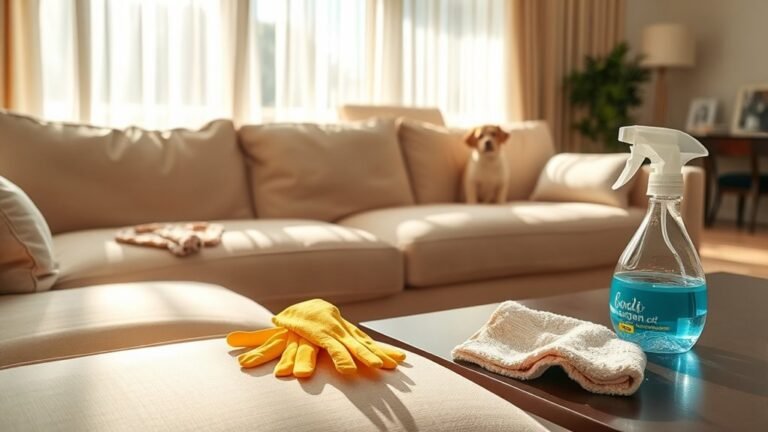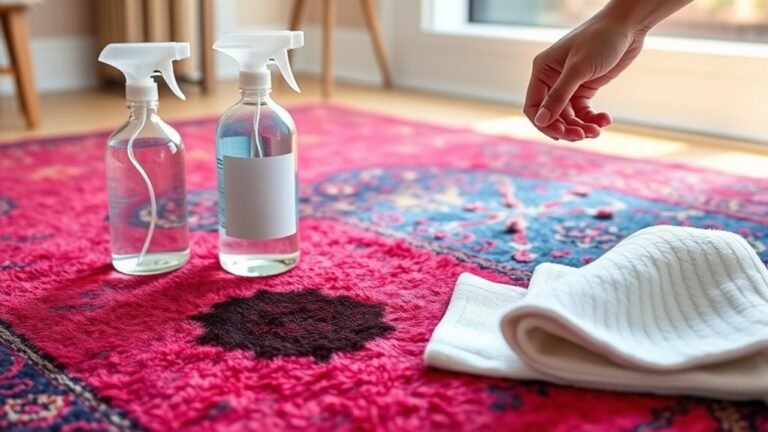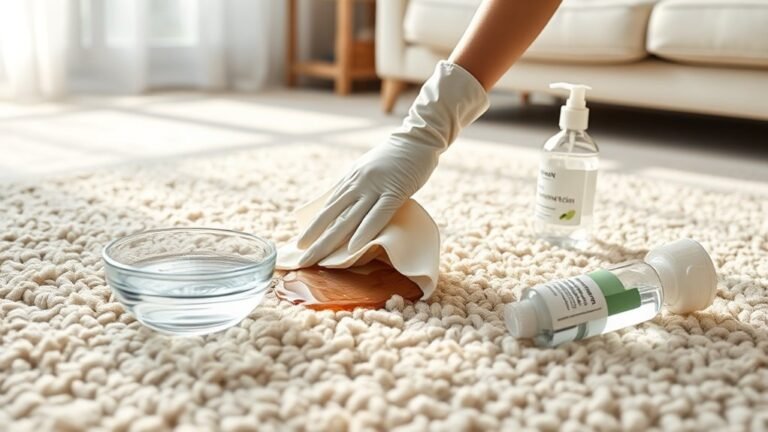Mistakes to Avoid When Cleaning Your Pet Mess
When cleaning your pet’s mess, don’t use harsh chemicals that might irritate their skin or harm your home. Avoid ignoring stains, as that lets bacteria and odors worsen. Always blot instead of rubbing to prevent pushing mess deeper into fabrics. Test cleaners on a small spot first to avoid damage, and don’t overwet areas to stop mold growth. It’s also key to neutralize odors instead of just masking them. Understanding these tips can help you tackle pet messes more effectively.
Using the Wrong Cleaning Products

One of the biggest mistakes you can make when cleaning pet messes is using the wrong cleaning products. Harsh chemicals may seem effective, but they can irritate your pet’s skin or worse, be toxic if ingested. Understanding different cleaning product types is essential for maintaining a safe environment. Opt for pet safe alternatives like enzymatic cleaners designed to break down organic stains and odors without harmful residues. These products not only protect your furry friend but also prevent repeat accidents by fully eliminating scents. By choosing wisely, you gain freedom from worry and create a healthier home for both you and your pet. Remember, your cleaning routine should safeguard your pet’s well-being while restoring your space efficiently and responsibly.
Ignoring the Mess for Too Long
Choosing the right cleaning products is a great start, but acting promptly is just as important when dealing with pet messes. Ignoring the mess for too long can lead to prolonged exposure to bacteria and unpleasant odors, increasing health risks for both you and your pet. The longer you wait, the harder it becomes to fully eliminate stains and smells. Prompt cleaning not only preserves your home’s hygiene but also prevents potential damage to carpets and upholstery. Remember, taking immediate action gives you greater control and freedom, ensuring your living space stays fresh and safe. Don’t let procrastination turn a simple cleanup into a bigger problem—you’ll thank yourself for addressing pet messes quickly and effectively.
Rubbing Instead of Blotting Stains

When tackling pet stains, using the right technique can make all the difference. One common mistake is rubbing instead of blotting stains. Rubbing pushes the mess deeper into the fabric or carpet fibers, making stain removal much harder and sometimes permanent. Instead, you want to use gentle blotting techniques—press a clean cloth or paper towel onto the stain to absorb it without spreading or embedding it further. This simple step preserves your freedom to enjoy a clean space without the frustration of stubborn marks. Remember, patience and a careful touch are key when dealing with pet messes. By mastering blotting techniques, you’ll improve your stain removal success and keep your home fresh and inviting.
Failing to Test Cleaners on a Small Area
Before using any cleaner on your pet’s mess, you need to test it on a small, hidden spot first. This simple step helps prevent damage to the surface and lets you see if the cleaner causes any color fading. Skipping this test can turn a manageable stain into a bigger problem.
Spot Test Importance
Why risk damaging your furniture or carpets by skipping a simple step? Spot test importance can’t be overstated when cleaning pet messes. Before applying any cleaner, you need to try spot test techniques on a hidden area to verify it won’t cause discoloration or fabric damage. This small precaution saves you from costly repairs and frustration. Also, remember spot test frequency—don’t just test once and assume it’s safe for all surfaces. Different materials might react differently, so test every time you use a new product or cleaner formula. Taking these steps gives you the freedom to clean confidently, protecting your home while keeping it fresh and safe for your pets. It’s a smart, responsible approach that every pet owner should adopt.
Avoid Surface Damage
Skipping the step of testing cleaners on a small, inconspicuous area can lead to unexpected surface damage. You want to protect your surfaces while effectively cleaning pet messes, so follow these key steps:
- Choose a hidden spot to apply your cleaner first. This helps guarantee the cleaning technique won’t cause discoloration or texture changes.
- Wait a few minutes to observe any adverse effects like fading, bubbling, or staining. Patience here safeguards your surface protection.
- If no damage appears, proceed confidently with cleaning. If issues arise, switch to a gentler product or alternative cleaning technique.
Detect Color Fading
How can you be sure your cleaning efforts won’t unintentionally cause color fading? The key lies in color detection before you plunge in. Always test your chosen cleaner on a small, hidden area first. This simple step helps you spot any fading signs early, protecting your surfaces from irreversible damage. Failing to do so can result in uneven discoloration that’s tough to fix. When you test, observe carefully—look for dullness, lightened patches, or altered hues. If you notice any fading signs, switch to a gentler cleaner or try natural alternatives. Taking this precaution grants you the freedom to clean effectively without sacrificing the vibrant look you want to preserve. Remember, a little patience now prevents regret later.
Overwetting the Affected Area
When you soak the area too much while cleaning pet messes, you risk pushing stains deeper and encouraging mold growth. Excess moisture can also damage flooring and fabrics, making the problem worse. To avoid this, use minimal liquid and guarantee thorough drying after cleaning.
Causes of Overwetting
Although it might seem like a good idea to thoroughly soak a pet mess, overwetting the affected area often does more harm than good. Understanding common overwetting causes helps you maintain proper moisture control and protect your home.
Here are three typical reasons you might overwet:
- Overestimating the cleaner’s strength – You may think more liquid equals better cleaning, but excess moisture can spread the mess or damage surfaces.
- Using improper tools – A heavy spray or soaked cloth often delivers too much liquid, making it harder to dry the area effectively.
- Rushing the process – Trying to clean quickly can lead to applying too much solution without letting the area dry between steps.
Risks of Excess Moisture
If you don’t control moisture while cleaning pet messes, you risk causing damage that’s often more difficult to fix than the original problem. Excess moisture leads to moisture buildup within carpets, upholstery, or flooring, creating an environment where mold and mildew can thrive. This not only causes unpleasant odors but also poses health risks to you and your pets. Water damage can weaken materials, resulting in stains that set permanently or structural issues in your home. You might think soaking the area thoroughly guarantees cleanliness, but overwetting actually traps moisture deep inside, prolonging drying time and increasing the chance of damage. Being mindful of how much liquid you use is essential to maintain a clean, safe, and healthy space—giving you the freedom to enjoy your home without hidden risks.
Proper Drying Techniques
One common mistake people make during pet mess cleanup is overwetting the affected area, which can do more harm than good. Overwetting can lead to lingering odors and mold growth, restricting your freedom to enjoy a clean home. To avoid this, follow these proper drying techniques:
- Use effective absorbents like microfiber cloths or paper towels to soak up moisture without saturating the area further.
- Confirm proper ventilation by opening windows or using fans to promote air circulation and speed up drying.
- Avoid flooding the spot with cleaning solutions; apply them sparingly and focus on blotting rather than scrubbing.
Neglecting to Neutralize Pet Odors
A common mistake when cleaning up after your pet is neglecting to neutralize the odors completely. Simply masking the smell won’t give you the fresh environment you deserve. Using proven odor neutralizing techniques and effective pet deodorants guarantees that odors are eliminated at the source, freeing your home from lingering scents. Here’s a quick guide to help you choose the right approach:
| Cleaning Method | Pros | Cons |
|---|---|---|
| Enzymatic Cleaners | Break down odor molecules | May require multiple applications |
| Baking Soda | Natural, inexpensive | Less effective on strong odors |
| Vinegar Solution | Kills bacteria | Strong smell initially |
| Commercial Deodorants | Quick and easy | Contains chemicals |
| Activated Charcoal | Absorbs odors | Slow to show results |
Implement these strategies for a truly odor-free space.
Frequently Asked Questions
How Often Should I Deep Clean My Pet’S Living Area?
You should deep clean your pet’s living area at least once a week to maintain a healthy environment. While daily maintenance like spot cleaning helps keep things fresh, adjusting your cleaning frequency based on your pet’s habits and space size is key. This routine guarantees odors and bacteria don’t build up, giving you and your pet freedom from discomfort and health issues. Consistency is your best friend here.
Can Pet Messes Cause Allergies in Humans?
Yes, pet messes can definitely cause allergies in humans. When you don’t clean up thoroughly, pet allergens like dander, saliva, and urine can build up, triggering allergy symptoms such as sneezing, itchy eyes, or congestion. It’s important you keep your pet’s living area clean and well-ventilated to reduce these allergens. By managing messes promptly, you protect your health and enjoy the freedom of living comfortably with your furry friends.
What Are the Best Tools for Cleaning Pet Hair?
When tackling pet hair, you’ll want a vacuum designed specifically for it. Look for vacuum types with strong suction, HEPA filters, and specialized pet hair attachments to capture even the finest strands. Upright and canister vacuums with motorized brush rolls work wonders on carpets, while cordless stick vacuums offer freedom to reach tight spots. Investing in the right tools makes cleaning easier, so you can enjoy your space without pet hair worries.
How Can I Prevent My Pet From Making Messes Again?
To prevent your pet from making messes again, focus on consistent behavior training that reinforces good habits. Use positive reinforcement to encourage your pet when they behave well, making mess prevention a natural part of their routine. Set clear boundaries and provide plenty of mental and physical stimulation to reduce destructive behavior. With patience and consistency, you’ll enjoy a cleaner home and a happier pet—giving you both the freedom to relax without worry.
Are Natural Cleaning Solutions Safe for Pets?
You’ll find natural alternatives like vinegar, baking soda, and lemon juice are generally safe for cleaning around your pets when used properly. However, not all natural solutions are pet safe products—some essential oils can be harmful. Always double-check ingredients and opt for pet-specific natural cleaners to keep your furry friends safe. Using these alternatives gives you peace of mind while maintaining a clean home without harsh chemicals restricting your freedom.






